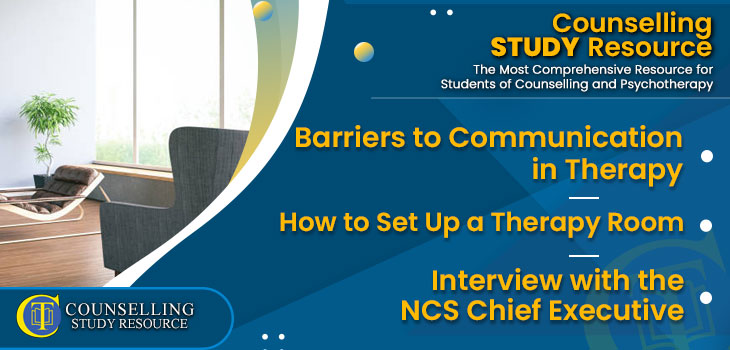265 – How to Set Up a Therapy Room
Barriers to Communication in Therapy – Interview with the NCS Chief Executive
In Episode 265 of the Counselling Tutor Podcast, your hosts Rory Lees-Oakes and Ken Kelly are back with this week’s three topics:
- Firstly in ‘Theory in Practice’ we look at barriers to communication in counselling.
- Then in ‘Practice Today’, Rory and Ken discuss how to set up a therapy room.
- And lastly in ‘Practice Matters’, we see the end of our 6-week-long series looking into the National Counselling Society (soon to be the National Counselling and Psychotherapy Society) by speaking with CEO Jyles Robillard-Day.
Barriers to Communication in Therapy [starts at 02:13 mins]
Counselling Foundations is sponsored by
Counselling Skills Academy
Learn counselling techniques by seeing counselling skills used in real sessions by qualified therapists.
Real sessions - real-life presentations - real skills.
When it comes to communicating with your client, you can be met with a series of unexpected circumstances. Listen in this section as Rory and Ken discuss some of the barriers you might come across in counselling, and how you might go about tackling them:
- Communication is the successful conveying or sharing of ideas and feelings. If something gets in the way of those ideas and feelings being either shared, or received and understood, it’s likely there is a barrier of some sort preventing this.
- The different types of barriers:
- External/environmental barriers – noise disruption (e.g. construction), a bad connection if working online.
- Internal barriers - neurodiversity.
- Cultural barriers – language, this may also include economic/class differences.
- Topic barriers – are there any topics you feel uncomfortable talking about?
- Jargon – occupation-specific vocabulary or even dialect.
- Are there any topics of conversation that you find yourself shying away from? E.g. sex, sexuality, race, religion. If this is the case, you should look into why these subjects maybe make you feel shy/embarrassed/uncomfortable. If you feel uncomfortable discussing them, the client will too.
- Barriers work both ways.
- Clarifying – if you’re not sure you understand what a client has said, clarify.
- Practice recognising barriers and learn the different kinds. Think about what you might do if met with a barrier, this helps you be prepared for if it does come up in a session.
- Recognise communication barriers in your own life, journal them, take them to supervision and think about why they might be there.
- Seek CPD on subjects you’re not sure on for a better understanding, this will help you to discuss them more comfortably with your client.
A handout on Barriers to Communication Cheat Sheet is available for download in the green button above.
How to Set Up a Therapy Room [starts at 19:27 mins]
The space you conduct your sessions in will have a huge influence on how comfortable your clients feel with you. In this section on how to set up a therapy room, Rory and Ken discuss some things to keep in mind:
- This is something important to consider both face-to-face and online.
- When setting up your therapy room, keep in mind that the space should enact permission for the client to cry; they should feel like they're in a safe space.
- Is the room private? Soundproof? Is confidentiality compromised in any way?
- Is the space accessible? If not, for example if there are stairs, this needs to be made clear to your clients before they choose to take sessions with you.
- Another consideration when setting up a therapy room is sensory accessibility. Is the room too hot or too cold? Is there a ticking clock? A flickering light? A strong smell?
- Is there access to a toilet?
- Making sure the space is neat and clean.
- Working with the space you’ve been given, thinking of ways you can make it feel more comfortable.
- Asking the client if the room is okay, if there is anything that makes them uncomfortable and if you can solve that. E.g. a client may be uncomfortable with seeing their reflection, in which case you would turn any mirrors you may have in the room.
- When working online – think about your backdrop. Would it be beneficial to have a digital backdrop?
- Keep your decorations neutral, you don’t want to give too much of yourself away e.g. family photos, your faith position.
Interview with the NCS Chief Executive [starts at 34:58 mins]
The National Counselling Society is proud to sponsor Practice Matters.
NCS are really excited to have launched their Children and Young People Therapist Register for counsellors working with the younger age group.
In this week’s ‘Practice Matters’, Rory speaks with Jyles Robillard-Day, the CEO of the NCS (soon to be NCPS), bringing an end to our series getting an insight into professional bodies.
The key points of this discussion include:
- The National Counselling Society try their best to help the individual.
- A responsive team: personal, friendly and quick responses to questions.
- Member benefits.
- They believe in the importance of public protection.
- They have a fair and robust complaints process.
- Giving people who want counselling a choice in who they choose to do it with.
- Improves public confidence – the public can trust that whoever they choose to have counselling with is ethical and trained.
- Campaigning for change.
- They have a huge list of fully trained and qualified counsellors ready to help people.
- Making an effort to listen to member feedback and take action.


